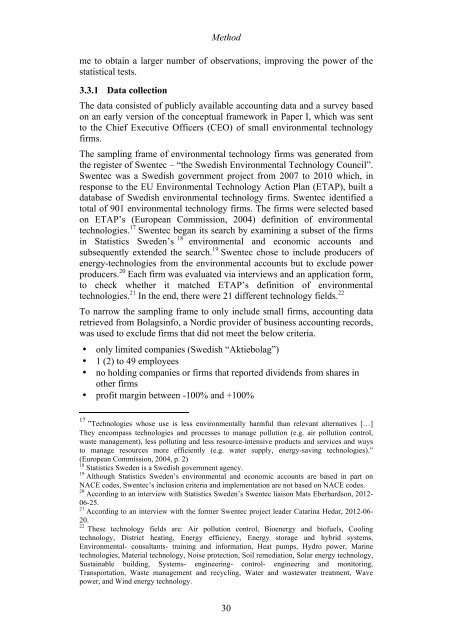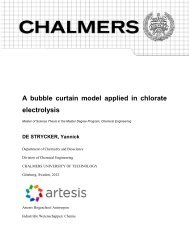Paper separationsblad - Chalmers tekniska högskola
Paper separationsblad - Chalmers tekniska högskola
Paper separationsblad - Chalmers tekniska högskola
You also want an ePaper? Increase the reach of your titles
YUMPU automatically turns print PDFs into web optimized ePapers that Google loves.
Method<br />
me to obtain a larger number of observations, improving the power of the<br />
statistical tests.<br />
3.3.1 Data collection<br />
The data consisted of publicly available accounting data and a survey based<br />
on an early version of the conceptual framework in <strong>Paper</strong> I, which was sent<br />
to the Chief Executive Officers (CEO) of small environmental technology<br />
firms.<br />
The sampling frame of environmental technology firms was generated from<br />
the register of Swentec – “the Swedish Environmental Technology Council”.<br />
Swentec was a Swedish government project from 2007 to 2010 which, in<br />
response to the EU Environmental Technology Action Plan (ETAP), built a<br />
database of Swedish environmental technology firms. Swentec identified a<br />
total of 901 environmental technology firms. The firms were selected based<br />
on ETAP’s (European Commission, 2004) definition of environmental<br />
technologies. 17 Swentec began its search by examining a subset of the firms<br />
in Statistics Sweden’s 18 environmental and economic accounts and<br />
subsequently extended the search. 19 Swentec chose to include producers of<br />
energy-technologies from the environmental accounts but to exclude power<br />
producers. 20 Each firm was evaluated via interviews and an application form,<br />
to check whether it matched ETAP’s definition of environmental<br />
technologies. 21 In the end, there were 21 different technology fields. 22<br />
To narrow the sampling frame to only include small firms, accounting data<br />
retrieved from Bolagsinfo, a Nordic provider of business accounting records,<br />
was used to exclude firms that did not meet the below criteria.<br />
• only limited companies (Swedish “Aktiebolag”)<br />
• 1 (2) to 49 employees<br />
• no holding companies or firms that reported dividends from shares in<br />
other firms<br />
• profit margin between -100% and +100%<br />
17 ”Technologies whose use is less environmentally harmful than relevant alternatives […]<br />
They encompass technologies and processes to manage pollution (e.g. air pollution control,<br />
waste management), less polluting and less resource-intensive products and services and ways<br />
to manage resources more efficiently (e.g. water supply, energy-saving technologies).”<br />
(European Commission, 2004, p. 2)<br />
18 Statistics Sweden is a Swedish government agency.<br />
19 Although Statistics Sweden’s environmental and economic accounts are based in part on<br />
NACE codes, Swentec’s inclusion criteria and implementation are not based on NACE codes.<br />
20 According to an interview with Statistics Sweden’s Swentec liaison Mats Eberhardson, 2012-<br />
06-25.<br />
21 According to an interview with the former Swentec project leader Catarina Hedar, 2012-06-<br />
20.<br />
22 These technology fields are: Air pollution control, Bioenergy and biofuels, Cooling<br />
technology, District heating, Energy efficiency, Energy storage and hybrid systems,<br />
Environmental- consultants- training and information, Heat pumps, Hydro power, Marine<br />
technologies, Material technology, Noise protection, Soil remediation, Solar energy technology,<br />
Sustainable building, Systems- engineering- control- engineering and monitoring,<br />
Transportation, Waste management and recycling, Water and wastewater treatment, Wave<br />
power, and Wind energy technology.<br />
30















